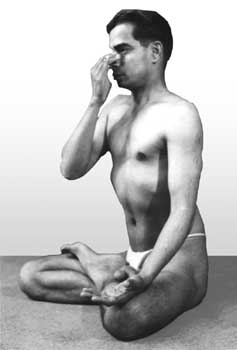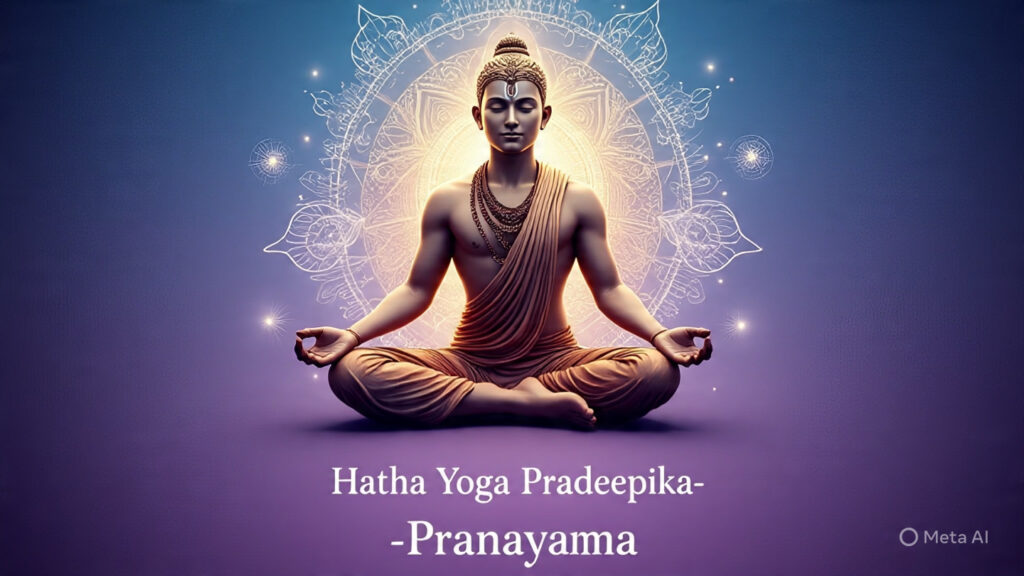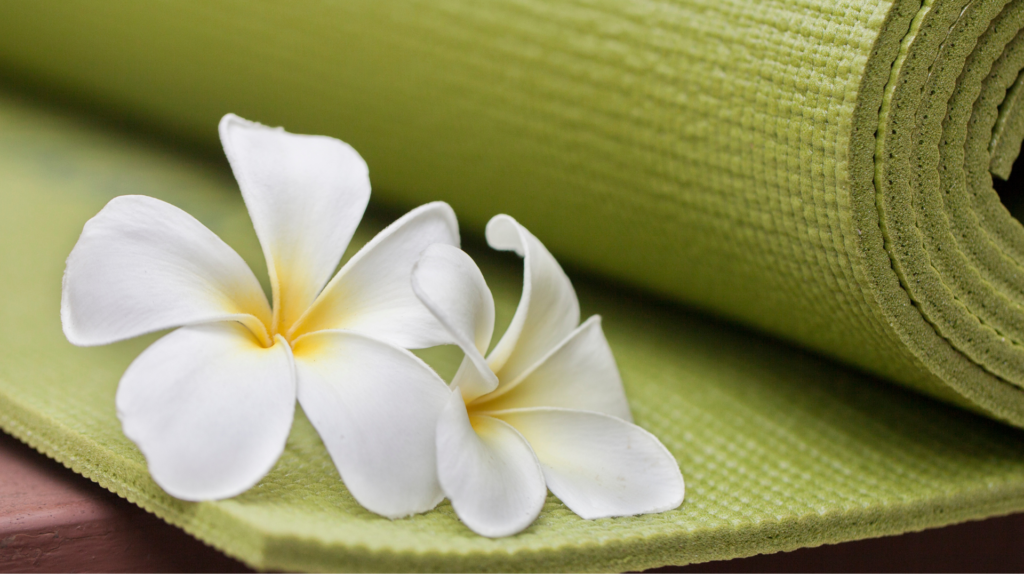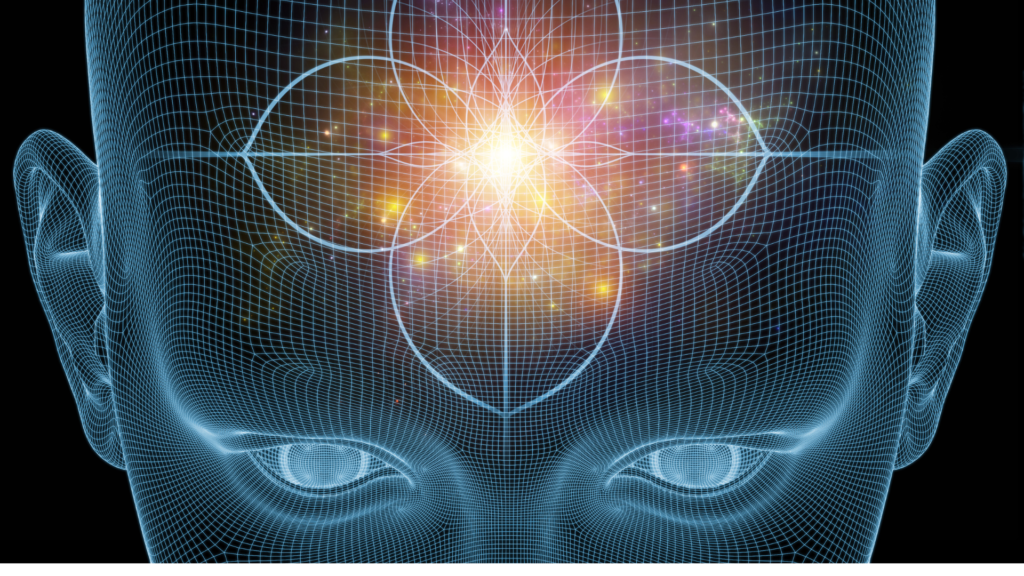Hatha Yoga Pradeepika – Chapter 2 – Pranayama

- Once a yogi has perfected asanas, he should maintain a beneficial and moderate diet and practice pranayama as instructed by his Guru.
- When the breath is disturbed, the mind becomes disturbed. Similarly, when the breath is still, so is the mind.
- For as long as there is breath in the body, there is life. As soon as breath leaves the body, death occurs. Hence, the need to restrain the breath.
- Owing to impurities in the nadis, the breath does not pass through the middle channel. So, how can one achieve the state of the precious gem (unmani). How does one achieve perfection (siddhi)?
- When all the nadi’s are cleansed, then the yogi is able to restrain the breath.
- So, pranayama should be practiced with sattvik intent, till the sushumna nadi is cleansed completely.
- Sitting in Padmasana, the yogi inhales through the Moon nostril (Ida or left nostril). Then, retaining it to one’s ability, he exhales through the Sun (Pingala or right nostril).
- Similarly, drawing in air through the Sun nostril (right nostril), the belly should be filled. Thereafter, performing Kumbhaka as before, the air should be exhaled through the Ida.
- Inhaling thus, through the one through which air was expelled, and having retained it to the utmost, it should be exhaled through the other, slowly, not fast.
- If the air be inhaled through the Ida, it should be expelled through the Pingala. Similarly, if it is drawn in through the Pingala and retained there, it should be expelled through the Ida. Thus, those that practice thus through the Sun and Moon should have clean Nadis after 3 months or so.
- Morning, noon, evening and night, one should practice Kumbaka until one is able to do 80 in one sitting.
- In the beginning, there is perspiration, in the middle there is trembling, and in the final stage there is steadiness in the breath.
- The perspiration from the exertion should be rubbed into the body (and not wiped), for this makes the body firm, yet light.
- Initially, food mixed with milk and ghee is prescribed. However, when practice is advanced, such restrictions need not be observed.
- Just as lions, elephants and tigers should be brought under control gradually, the same method should be adopted for controlling the breath. Otherwise, it can be very destructive on the practitioner.
- Proper practice of pranayama results in eradication of disease, but improper practice results in disease.
- Hiccups, asthma, cough, pain in the head, ears and eyes and many other illnesses are related to the regulation of the breath.
- In fact, air should be exhaled and inhaled in a proper manner. Also, it should be retained properly for best results.
- When the nadis are purified, there are external signs such as a lean body, glowing body.
- When one is able to restrain the breath, the gastric fires become more active and one can hear the naada (inner sound) from implementing correct breathing discipline.
- For those having excess fat or phlegm, six kriyas (actions) should be practiced. Others, who have these doshas (humours) in balance, need not practice these kriyas.
- Dauti, basti, neti, trataka, nauli, kapala bhati, these six kriyas should be practiced.
- These six actions which cleanse the body should be kept secret. The produce unbelievable results and held in great esteem by yogis.
- Dhauti – a wet strip of cloth, 4 fingers wide and 15 spans long is swallowed as directed by the Guru and then taken out. This is called Dauti karma.
- Cough, asthma, disease of the spleen, leprosy and other diseases brought about by phlegm disappear by dauti.
- Basti – Sitting in navel deep water in Utkatasana pose (resting on the toes of the feet with heels pressed into the buttocks), insert a smooth tube into the anus for half its length. The water should be drawn in and expelled. This is called Basti karma.
- By practicing basti, colic, enlarged spleen, dropsy and other disorders arising from vata (air), pitta (bile) and kapha (phlegm) are cured.
- The practice of Basti refines the body constitution (dhatus), sense organs (indriyas) and internal movement organs (antahkarana). It makes the body glow and increases digestion. All disorders disappear.
- Neti – a smooth thread of the length of a handspan should be inserted through the nasal passage and drawn out through the mouth. This is called Neti karma.
- Neti cleanses the brain and makes the sight capable of perceiving subtle things. It also removes all diseases of the cervical and head.
- Trataka – Gaze steadily at a minute object until tears are shed. This is called trataka by teachers.
- Trataka destroys eye diseases and removes laziness. It should be kept secret.
- Nauli – Sitting on the toes with heels above the ground, the belly should be vigorously moved from left to right and right to left as in vomiting. This is called Nauli.
- Nauli removes dyspepsia, increases digestion ability, produces happiness and destroys all diseases and disorders of the dosha (humours).
- Kapalabhati – when inhalation and exhalation are performed rapidly like the bellows of a blacksmith. This is called Kapalabhati which overcomes orders of phlegm.
- When one is freed from obesity and phlegm by practicing the 6 acts and subsequently practices pranayama, the practitioner will achieve success without difficulty.
- Some teachers opine that practice of pranayama removes all defects and is adequate and these 6 acts need not be practiced.
- Draw the apana to the throat and vomit the substances that are in the stomach. This brings all the nadis under control and is called Gajakarani by those who know Hatha Yoga.
- Brahma and the Devas devoted themselves to the practice of Pranayama and got rid of the fear of death. So, one should practice the control of breath.
- So long as breath is restrained in the body, the mind is calm and steady, the gaze fixed between the eyebrows, this will remove the fear of death.
- When the Nadis are purified by the practice of pranayama, then the prana force open the doorway of susumna and enters it easily.
- When the prana moves in the sushumna, the mind becomes steady and this is called Manonmani.
- To attain this state, experts practice various types of Kumbhakas. With the practice of different kumbaka, diverse siddis are obtained.
- The various Kumbakas are eight in numbers – Suryabhedana, Ujjayi, Sitkari, Sitali, Bhastrika, Bhramari, Murcha and Plavini.
- At the end of Puraka, Jaladhara banda should be performed. At the end of Kumbaka and before start of rechaka, uddiyana should be practiced.
- By contracting the anus from below (moola bandha), contracting the throat (jalandhara bandha) and simultaneously sucking in the abdomen in, uddiyana, the prana enters the susumna nadi.
- By raising the apana vayu and forcing the prana vayu down from the throat, the yogi becomes youthful, like a 16 year old. (Sivasamhita – Seat of the prana vayu is the heart, apana vayu is the anus, samana vayu is centered around the navel, udana vayu around the throat and vyana vayu moves throughout the body.)
- Surya bhedana – Assuming any comfortable seating posture, the yogi should draw in air slowly through the right nostril (Pingala or Surya nadi)
- He should then retain the breath until it is felt from the hair to the ends of the nails after which he should exhale slowly through the left nostril (Chandra nadi or Ida).
- Suryabedana cleanses the frontal sinuses, destroys diseases related to Vata and maladies caused by worms.
- Ujjayi – Close the nadi in the throat and draw in air such that it goes touching the throat to the chest while making a noise in passing.
- Perform kumbaka and exhale through the Ida (left nostril). This removes sleshma (phlegm) in the throat and increases gastric fires.
- It destroys the defects of the nadis, the doshas and dropsy. Ujjayi should be performed in all conditions, even while walking or sitting.
- Sitkari – draw the air in though the mouth, keeping the tongue between the teeth. Exhale the air through the Ida. By practicing this way, one becomes next to Kama (god of love).
- He is highly regarded by yogis, he is able to create and destroy. He is not suffer from hunger thirst, somnolence or laziness
- The harmony (sattva) of his body becomes one free from affliction and the practitioner becomes a lord among yogis.
- Sitali – Inhale air over the protruding tongue outside the lips, practice kumbaka as described above. The intelligent practitioner then expels air through the nostrils.
- Colic, enlarged spleen, fever, illness associated with bile, hunger, thirst and poisons are cured by the practice of shitali kumbaka.
- Bhastrika – When the feet are placed on the opposite thighs, it is called Padmasana, the destroyer of all sins.
- Assuming balanced Padmasana and an erect body, the intelligent practitioner should exhale through the nostrils.
- It should then be inhaled rapidly with force until there is an experience of resound in the heart, throat upto the skull.
- It should be expel repeatedly and filled again and again like a blacksmith using his bellows.
- In the same manner, he should move the prana within the body and when experiencing fatigue, inhale using the right (Pingala) nostril.
- As soon as the lungs are filled quickly with air, the right nostril should be closed with the ring finger and kept confined.
- Having performed Kumbhaka properly, it should be expelled through the left nostril. This destroys vata (air), pitta (bile) and kapha (phlegm) and increases gastric fires.
- The Kundalini is quickly aroused; pleasant, purifying and beneficial. Any phlegm and other impurities which may be accumulated at the entrance to the brahma nadi are destroyed.
- Bhastrika should be performed plentifully for it breaks the 3 knots that are firmly placed on the sushumna. (Brahman granthi in the anahata, Vishnu granthi in the vishuddhi and Rudra granthi in the ajna)
- Brahmari – Inhale forcefully, making a sound like the hum of a bee, exhale slowly making the same sound. This practice brings indescribable ecstasy to yogis.
- Murcha – at the end of puraka, assume jalandhara bandha; expel the air slowly, this is called murchha and it causes the mind to become calm.
- Plavini – When the belly has been filled completely with air, and the insides are filled to the utmost with air, the body will float on water like a lotus leaf even in the deepest water.
- Pranayama consists of 3 aspects – rechaka (exhaling), puraka (inhaling) and kumbhaka (holding) when puraka and rechaka are considered. But without these, there are only 2 kinds, sahita (with) and kevala (isolated).
- One should practice sahita until one achieves success in kevala. The latter is merely confining of air without rechaka and puraka.
- In the practice, when it can be performed without rechaka or puraka, this pranayama is called kevala kumbaka.
- There is nothing in the world that a person cannot achieve by the practice of kevala kumbaka where he keeps the air confined within.
- Success in Raja Yoga is achieved, without doubt. Through kumbhaka, kundalini is aroused, and by this awakening, the sushumna becomes free from impurities.
- One cannot obtain success in Raja Yoga without Hatha Yoga, nor success in Hatha yoga without Raja Yoga. Hence, both should be practiced till success is obtained.
- At the end of retention of breath in kumbhaka, the mind should be free of objects. By practicing thus, success is achieved in Raja Yoga.
- The signs of perfection in Hatha Yoga are – the body becomes lean, the face glows with joy, there is manifestation of inner sound (antahatanada), eyes are clear, freedom from disease, control over seminal discharge, stimulation of digestive fires and complete purification of the nadis.


